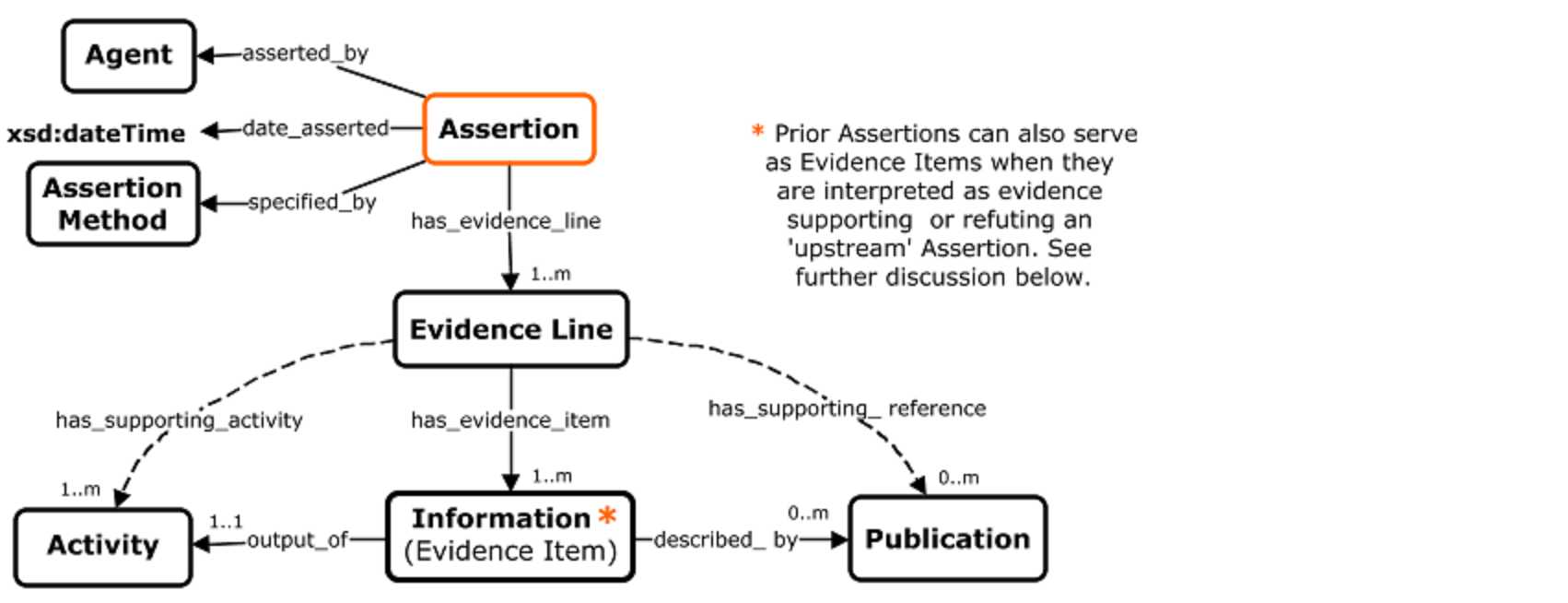Assertion

Definition: A statement of purported truth, as made by a particular agent on a particular occasion, based on the evaluation of one or more lines of evidence. Also known as a 'Claim'.
Supertypes: Information Content Entity > Statement
Subtypes: Annotation, Hypothesis, Diagnosis, Variant Interpretation, . . .
Description:
Assertions put forth a Proposition [1] that an Agent purports to be true. SEPIO describes 'scientific' Assertions, which are the result of some inference or conclusion drawn from a critical evaluation of evidence. This view of Assertions distinguishes them from unsubstantiated claims or accounts of directly observed facts - as such direct observations, or statements are made in the absence of evidence and inference. More on the distinctions between these different types of statements, and implications for modeling patterns in SEPIO, can be found in [2].
The identity of a particular Assertion is dependent upon what it claims (i.e. the Proposition it puts forth as true), the Agent asserting it, and the occasion on which the Assertion is made. Many Agents can make Assertions expressing belief in the same Proposition - e.g. Dr. Smith's Assertion that "Lepr leptin receptor inactivation can contribute to diabetes" is a separate instance from Dr. Jones' Assertion of the same underlying Proposition, which may be based on the same or entirely different evidence. Likewise, a single Agent can make more than one Assertion of belief in the same Proposition on different occasions - e.g. Dr. Smith may make a separate Assertion of this Proposition at a later date, based on new evidence.
Examples:
- Dr. Smith's Assertion that "Lepr leptin receptor inactivation can contribute to diabetes".
- Dr. Jones' Assertion that "Lepr leptin receptor inactivation can contribute to diabetes".
- Dr. Stanley's Assertion that "Lepr leptin receptor inactivation does not contribute to diabetes".
An Assertion is the root entity in most* SEPIO models, which serve to describe the provenance of the Assertion and the evidence and reasoning supporting it. However, an Assertion can also serve as an Evidence Item for some upstream Assertion in the model. These are informally referred to as 'prior Assertions'. A key feature of the SEPIO model is that it can be extended arbitrarily many times to support the description of the provenance and evidence of such prior Assertions. In this way chains of Assertions can be created, linked by Evidence Lines that describe how one is used as evidence for another. For an example, see the two-tiered ClinGen/ACMG Variant Interpretation data example [3].
* SEPIO also supports models rooted at Propositions, which aggregate evidence across all Assertions that express the same Proposition (or directly contradicting Propositions). This gives a picture of the total evidence that exists for or against a particular Proposition, as opposed to all evidence used by one of many Assertions that put it forth. See [2] for more.
Assertion inherits from Information Content Entity, and adds the following attributes or constraints:
| Property | Value Type | Cardinality | Description |
|---|---|---|---|
| asserted_by | Agent | 1..1 | The Agent who made the Assertion. If more than one Agent is involved, consider them collectively as a group or organization. |
| date_asserted | xsd:dateTime | 1..1 | The date and time on which the Assertion was originally made. |
| is_specified_by | Assertion Method | 0..m | The method (e.g. a protocol, guideline, rule set) that specifies how the Assertion was generated by some Agent (e.g. what types of data may be used as evidence, how to weight and combine Evidence Lines to make a final Assertion. |
| has_evidence_line | Evidence Line | 1..m | An Evidence Line that is used to evaluate the validity of the Proposition put forth by the Assertion. Scientific claims have at least one Evidence Line supporting them. |
| assertion_validated_by | Agent | 0..m | An Agent who validates the quality of an Assertion. Validation is common practice in many assertion pipelines, e.g. clinical variant interpretation performed by ClinGen or CIViC. |
| date_validated | xsd:dateTime | 0..m | The date and time at which the Assertion is validated as meeting a defined standard of quality or rigor. |
| assertion_confidence_level | Value Set | 0..1 | A qualitative value assigned to an Assertion that indicates the degree of confidence that the Proposition it puts forth is true. e.g. CIViC 'trust ratings' [4] assign confidence levels based on a 5-star scale. |
| assertion_confidence_score | integer or float | 0..1 | A quantitative value that is calculated as an indicator of the degree of confidence that the Proposition put forth by an Assertion is true. |
| has_evidence_from_source | Publication | 0..m | A shortcut relation used to directly link an Assertion to a resource (e.g. a Publication) that describes evidence used to evaluate its validity. |
| asserts | Proposition | 1..1 | The Proposition that is put forth as true by the Assertion. |
- Formal Representation of Assertion and Proposition Semantics [5]
- https://github.com/monarch-initiative/SEPIO-ontology/wiki/Proposition
- TO DO
- https://github.com/monarch-initiative/SEPIO-ontology/wiki/ClinGen-ACMG-Variant-Interpretation
- https://civic.genome.wustl.edu/help/evidence/trust-ratings
- TO DO
Jump to: Information Content Entity | Evidence Item | Evidence Line | Agent | Activity | Contribution | Statement | Proposition